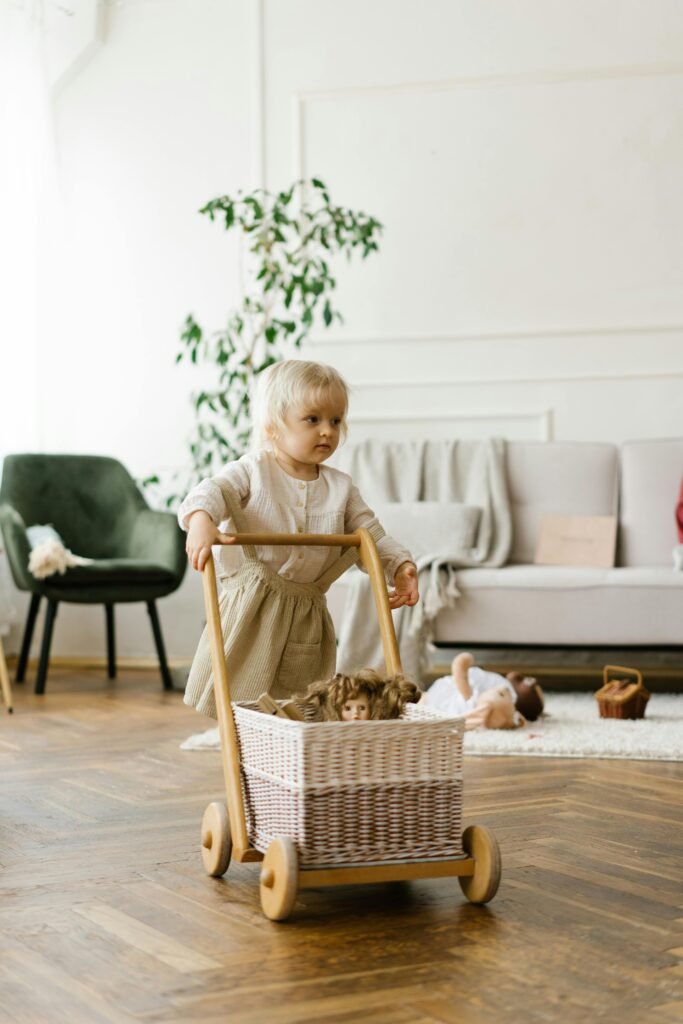
Children’s trolleys are more than just mini versions of supermarket carts—they are tools for imaginative play, mobility training, and even behavioural development. Over the years, these pint-sized trolleys have evolved from simple push toys to multifunctional products found in homes, preschools, and retail outlets across the UK. In 2025, they are experiencing a surge in popularity driven by improved safety designs, more realistic aesthetics, and a strong emphasis on hands-on learning. Whether you’re a parent, early childhood educator, or someone curious about how children’s trolleys aid development and fit into modern parenting, this article offers a complete and current perspective.
What Are Children’s Trolleys?
Children’s trolleys are small, lightweight carts designed for toddlers and young children to push or pull. They often resemble adult supermarket trolleys or shopping carts but are scaled down in size and weight. Some are used for roleplay—such as pretend shopping—while others are designed to help improve walking and balance in early development stages. Modern versions come in a variety of materials including plastic, wood, and lightweight metal. Many feature compartments, toy food items, and even child-safe wheels. Their appeal lies in blending functionality with creativity, giving children something practical that also fuels their imagination.
Why Are Children’s Trolleys Popular in 2025?
In 2025, the resurgence in traditional and open-ended toys is noticeable. According to a July 2025 report from the UK Toy Retailers Association, there has been a 21% increase in sales of roleplay toys, with children’s trolleys ranking among the top-selling items. Parents and educators alike cite the value of unplugged, screen-free play that promotes real-world skills.
Social media platforms such as TikTok and Instagram have also contributed to their popularity, where influencers show their children using mini shopping trolleys in home setups, kids’ parties, and themed play areas.
Eco-conscious parenting is another driver of growth. Wooden trolleys with sustainable materials are being promoted by ethical brands and small businesses across the UK. The intersection of functionality, sustainability, and fun has helped children’s trolleys reclaim centre stage in 2025.
Benefits of Children’s Trolleys for Development
- Children’s trolleys offer both physical and cognitive development benefits. They are especially useful in the 1 to 5-year age group.
- On a physical level, pushing a trolley helps strengthen core muscles and improves balance and coordination. It’s a low-risk way to support toddlers transitioning from crawling to walking. For children with motor skill challenges, paediatric therapists often incorporate similar push-along trolleys into daily routines.
- Cognitively, trolleys support roleplay scenarios that enhance vocabulary, sequencing, and social skills. For example, children mimicking grocery shopping often practise categorisation, memory, and storytelling.
What Types of Children’s Trolleys Are Available?
The 2025 market includes a variety of children’s trolleys:
- Plastic supermarket-style trolleys are ideal for toddlers and often come with play food items. Wooden trolleys are more eco-friendly and durable, appealing to parents who prefer sustainable toys. Hybrid models with features like folding seats for dolls or magnetic accessories cater to more advanced imaginative play.
- Some trolleys are multi-use and can be converted into walkers or storage bins when not in play mode. Brands such as Melissa & Doug, Bigjigs, and IKEA continue to innovate in this category, with newer models offering rubber wheels for quiet indoor use and ergonomic handles to fit small hands.
Real-Life Use Cases in Homes and Schools
Children’s trolleys are becoming common in both home and institutional environments. In nurseries and early years classrooms, they’re used to reinforce themes like healthy eating or community roles. In domestic settings, parents use them to build household routines such as ‘pretend shopping’ or tidying up toys.
For example, in Liverpool, the Little Steps Preschool introduced roleplay corners with children’s trolleys in early 2025. Teachers reported improved cooperation and verbal skills during group playtime. At home, parents often say that having a trolley allows children to feel involved in shopping routines, whether in play or real trips to the store with toy-filled trolleys.
Safety and Buying Considerations in 2025
While children’s trolleys are generally safe, there are important factors to consider. Look for rounded edges, BPA-free materials, and rubber wheels to avoid floor scratches. In 2025, there is a wider availability of UKCA-certified products (post-Brexit equivalent to CE markings), which meet stringent toy safety regulations.
Always check for age-appropriateness on packaging. Lightweight trolleys should be stable enough to avoid tipping, especially if used by early walkers. Avoid metal trolleys with sharp edges unless specifically labelled for child use.
Online reviews and community forums such as Mumsnet or Netmums provide valuable peer insights. Several parents in a June 2025 Mumsnet thread praised the IKEA Duktig trolley for its solid build and stylish finish.
FAQs About Children’s Trolleys
Are children’s trolleys suitable for outdoor use?
Yes, but models with rubber or plastic wheels fare better. Wooden trolleys should be kept indoors unless specified for dual use.
What age is best for a children’s trolley?
Most are suitable from 12 months to 5 years. Check the manufacturer’s guidance for weight and height limits.
Are they safe for toddlers?
Yes, as long as the trolley is well-balanced, has rounded edges, and is age-appropriate.
Do they come with play accessories?
Many do—particularly food items, boxes, and toy cans for shopping-themed play.
Can they help with walking development?
Absolutely. Paediatric therapists and parents often use them as walking aids to build motor skills and confidence.
Final Thoughts
Children’s trolleys have grown from basic push toys into multi-functional developmental tools embraced by parents, educators, and therapists alike. In 2025, their appeal lies not just in entertainment but in the valuable skills they promote. From encouraging walking to nurturing imagination and social interaction, they are versatile additions to any playroom or early education setting. With more design-conscious and safety-focused options than ever, children’s trolleys continue to roll forward as a top choice in child-led learning.
To read more: click here





